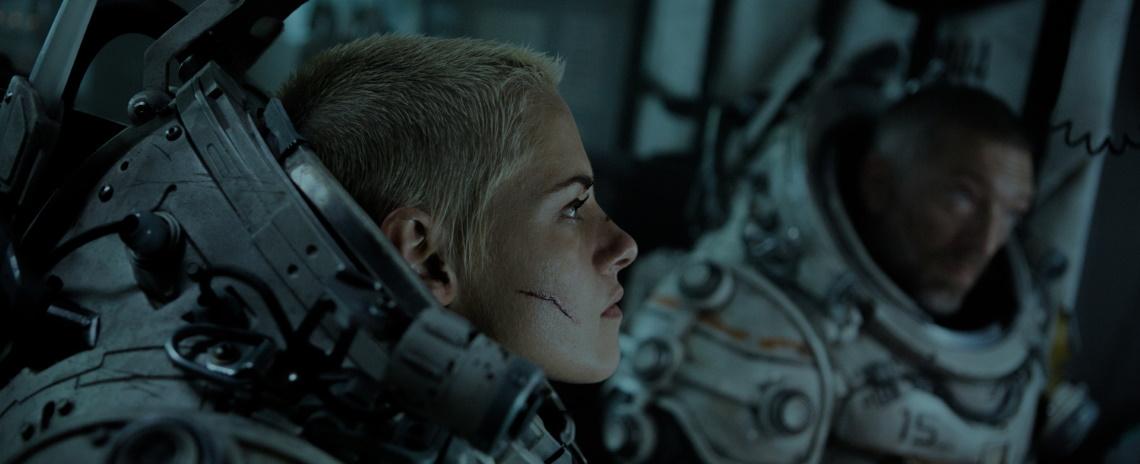It took a couple of years for Underwater to surface. Call it a preventative measure to avoid a case of the bends. The sale of 20th Century Fox to Walt Disney Studios loomed over the film’s 2017 production, and it seems that the new owners preferred to keep this film at bay for a bit … until they found the right time to dump it in the barren seascape that is the January box office. On some levels, Underwater has all the makings of a successful spring release. Life (2017), another Alien (1979) knockoff in the trapped-in-a-metal-vessel-with-killer-creatures subgenre, made more than $100 million in late March and early April, and Netflix’s The Cloverfield Paradox (2018) took the formula to streaming and saw record-breaking viewership. However, Underwater comes with only a fraction of the star power (and ad campaigns), which means that this could-be hit will likely drown and be swallowed whole.
That’s not to dismiss the work of Kristen Stewart or director William Eubank, though. Although the latter is not necessarily an A-list talent right now, Underwater argues that with the right script, he could level up at any time. Meanwhile, thanks to the positive critical response to Certain Women (2016) and Personal Shopper (2016), Stewart is a bigger name today than when Underwater was shot. The indie-movie all-star plays Norah, a mechanical engineer on the largest (and most environmentally problematic) deep-sea drill in history. In the middle of a cynical voiceover monologue about how she prefers to look at the world not as a glass half full but as one completely empty, disaster strikes Kepler 822 Station and its 300-odd crew members. As water bursts through walls and entire sections of the miles-long drill start imploding and drifting toward the seafloor, Norah leaps into action.
She’s soon joined by fellow crew members Rodrigo (Mamoudou Athie) and Paul (T.J. Miller, who hasn’t yet tried to make a comeback in the wake of the sexual-assault allegations filed against him — the film was simply made before his “cancellation”). The three of them pick up a few more stragglers on their way to the last remaining escape pods on the rig. As they travel from section to section, they begin to comprehend just how dire this catastrophe truly is. Capt. Lucien (Vincent Cassel) informs them that they’re going to have to don pressurized deep-sea suits and walk the rest of the way to safety. The supposed earthquakes that have rocked the Kepler have made their once-hermetic environment far too unstable to remain aboard any longer. It’s here that events shift from bad to worse for the crew: Not only does the pressure (some 10,000-plus pounds per square inch) prove to be too much for some of the suits, but the tremors that destroyed the Kepler weren’t tremors at all — they were a horde of killer squid-humanoid hybrids that bear a striking resemblance to Alien’s Chestbursters.
The script, written by Insurgent (2015) scribe Brian Duffield and The Legend of Tarzan's (2016) Adam Cozad, wastes no time on world-building or set-up. Choosing to sequester much of the need-to-know information to newspaper headlines and confidential documents in the opening credits allows for the fast-paced, no-frills story to kick into gear almost immediately. The viewer gets to know Stewart’s Norah through her voiceover monologue and an opening moment where she rescues a spider from drowning in the sink, two effective ploys that allow audiences to understand that she is both intelligent and quite compassionate. It makes her instantaneous response time to the Kepler’s imminent destruction as believable as if the film has spent 15 minutes on expository scenes of her interacting with crew members and doing her job. This front-end efficiency is the first of several surprises contained within the confines of this innocuous January release.
Another feat is the relatively smooth transition from disaster movie to creature feature that arrives around the midpoint of the film. While the first half relies heavily on genre tropes present in the filmography of Roland Emmerich (specifically The Day After Tomorrow [2004] and its environmentalist angle) as well as James Cameron’s ocean-set movies The Abyss (1989) and Titanic (1997), the back end leans more into monster-movie conventions as the crew is picked off by these unsettling underwater anomalies. Instead of exhausting one subgenre’s trappings by sticking with it from start to finish, Underwater blasts through both of these B-movie offerings without ever allowing either of them to tire out — moviegoers will hardly have time to notice that all the typical horror accoutrements are there guiding the feature along from point A to point B.
Admittedly, Underwater is far from a perfect film. No matter how slick it may appear in structure, the movie still suffers from a plethora of fatal flaws. The humor — spouting primarily from the mouth of Miller — often detracts from the tension, and it becomes very exhausting quite quickly. It’s one of the most grating aspects of the modern blockbuster, and, unfortunately, this lazy comic relief is present even seven miles below sea level. With a story so embedded in genre, there’s a certain suspension of disbelief required from the very start. The sudden shift from near-future disaster picture to Lovecraftian horror movie could prove to be alienating for those who haven’t seen the trailers, potentially leaving some viewers high and dry. It’s not the filmmaker’s job to please every audience member, but that doesn’t mean that those audience members raised and coddled on modern nine-figure crowd-pleasers will be satisfied with this peculiar piece of original sci-fi filmmaking. It’s unlikely that Underwater will recoup its $50 million budget, bring Miller out of his forced retirement, or propel Stewart to the top-level stardom of which she’s capable. However, it’s satisfying enough for those looking for a bit of recreational movie-going in the space between the Oscar-hopeful pileup in December and the alarmingly early kickoff of the summer-movie season in March.
Rating: C+


